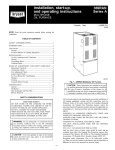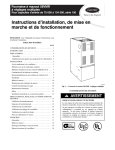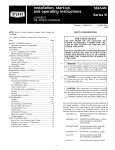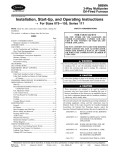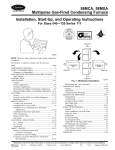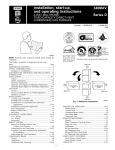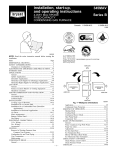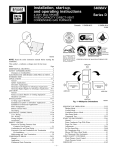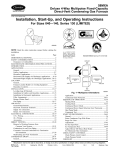Download Carrier OIL FURNACE 58CMA Operating instructions
Transcript
58CMA Series 130 Multipoise Oil Furnace Visit www.carrier.com Installation, Start-up, and Operating Instructions NOTE: Read the entire instruction manual before starting the installation. This symbol → indicates a change since last issue. TABLE OF CONTENTS SAFETY CONSIDERATIONS .....................................................1 INTRODUCTION ..........................................................................2 LOCATION....................................................................................3 General ......................................................................................3 Location Relative to Cooling Equipment ................................3 INSTALLATION ...........................................................................3 Air for Combustion and Ventilation ........................................3 General ......................................................................................4 Unconfined Space .....................................................................4 Confined Space .........................................................................4 All Air from Inside the Structure .......................................4 All Air from Outside of Structure ......................................5 Duct Work Recommendations ............................................5 Venting.................................................................................5 Oil Burner ............................................................................6 Oil Connections ...................................................................6 Barometric Draft Control ....................................................6 Electrical Connections.........................................................6 Horizontal or Downflow Installation ..................................7 Filters ...................................................................................7 START-UP, ADJUSTMENT, AND SAFETY CHECKOUT ......7 Operational Checkout ...............................................................7 Combustion Check....................................................................7 Fan Adjustment Check ...........................................................10 Limit Control Check...............................................................11 For Year-Round Air Conditioning .........................................11 Heating ....................................................................................11 Cooling ....................................................................................11 Constant Blower Switch .........................................................11 MAINTENANCE.........................................................................11 General ....................................................................................11 Oil Burner ...............................................................................11 Heat Exchanger and Flue Pipe...............................................11 Blower Removal .....................................................................12 SAFETY CONSIDERATIONS FOR YOUR SAFETY DO NOT STORE OR USE GASOLINE OR OTHER FLAMMABLE VAPORS AND LIQUIDS IN THE VICINITY OF THIS OR ANY OTHER APPLIANCE. DO NOT ATTEMPT TO START THE BURNER WHEN EXCESS OIL HAS ACCUMULATED, WHEN THE FURNACE IS FULL OF VAPOR, OR WHEN THE COMBUSTION CHAMBER IS VERY HOT. A97247 Fig. 1—58CMA Multipoise Oil Furnace For use with grade 1 or 2 Fuel Oil. Do not use Gasoline, Crankcase Oil, or any Oil containing Gasoline! Failure to follow this warning could lead to sooting, fire, explosion, and/or severe bodily harm. Never burn garbage or paper in the heating system and never leave rags, paper, or any flammable items around the unit. Failure to follow this caution will result in minor unit or property damage. These instructions are intended to be used by qualified personnel who have been trained in installing this type of furnace. Installation of this furnace by an unqualified person may lead to equipment damage and/or a hazardous condition which may lead to bodily harm. All local and national code requirements governing installation of oil burning equipment, wiring, and flue connections must be followed. Some of the codes (issued by the Canadian Standards Association, the National Fire Protection Agency, and/or the American National Standards Institute) that may be applicable are: Manufacturer reserves the right to discontinue, or change at any time, specifications or designs without notice and without incurring obligations. Book 1 4 PC 101 Catalog No. 535–80076 Printed in U.S.A. Form 58CMA-4SI Pg 1 9-03 Replaces: 58CMA-3SI Tab 6a 8a A TOP KNOCK-OUT FOR J DIAM VENT 20″ 19″ E 3″ G KNOCK-OUT BOTH SIDES FOR J DIAM VENT 19″ PULL VENT CONN B C OIL INLET (BOTH SIDES) 2″ D ELECTRICAL CONNECTIONS (BOTH SIDES) .88 DIAM TYP H L 20″ F K A98037 Dimensions (IN.) UNIT SIZE 105-12 120-20 A 35 39-1/2 B 48-3/4 53 C 30-1/4 32-1/4 D 16-5/8 18-3/4 E 20 24 F 22 28 G 12 12-9/32 H 14 16 J 5 6 K 1-1/2 1-5/8 L 1-3/4 1-1/2 Fig. 2—Dimensional Drawing ANSI/NFPA 31: INSTALLATION OF OIL BURNING EQUIPMENT ANSI/NFPA 211: CHIMNEYS, FIREPLACES, VENTS, AND SOLID FUEL BURNING APPLIANCES ANSI/NFPA 90B: WARM AIR HEATING AND AIR CONDITIONING SYSTEMS ANSI/NFPA 70: NATIONAL ELECTRICAL CODE CSA B139: INSTALLATION CODE FOR OIL BURNING EQUIPMENT CAS C22.1: CANADIAN ELECTRICAL CODE Understand the signal words DANGER, WARNING, CAUTION and NOTE. These words are used with the safety-alert symbol. DANGER identifies the most serious hazards which will result in severe personal injury or death. WARNING signifies a hazard which could result in personal injury or death. CAUTION is used to identify unsafe practices which would result in minor personal injury or product and property damage. NOTE is used to highlight suggestions which will result in enhanced installation, reliability, or operation. INTRODUCTION → The model 58CMA Furnaces are available in 2 sizes. Each size unit is capable of 3 heat/airflow combinations by a simple nozzle change. Unit 105-12 covers inputs of 70,000, 91,000, and 105,000 Btuh, and unit 120-20 covers inputs of 119,000, 140,000 and 154,000 Btuh. This eliminates the need to stock 6 separate units. Only the latest issues of these codes should be used, and are available from either The National Fire Protection Agency, Batterymarch Park, Quincy, MA 02269 or The Canadian Standards Association, 178 Rexdale Blvd., Rexdale, Ontario M9W 1R3 This furnace is a multipoise unit. It may be installed in the upflow, downflow or horizontal configuration. The furnace is shipped as a packaged unit, complete with burner and controls. It requires a line voltage (115 vac) connection to control box, a thermostat hook-up as shown on wiring diagram, oil line connection(s), adequate duct work, and connection to a properly sized vent. Recognize safety information. This is the safety-alert symbol . When you see this symbol on the furnace and in instructions or manuals, be alert to the potential for personal injury. 2 Table 1—Minimum Clearances To Combustible Materials (In.) Sides Back Top UNIT APPLICATION Furnace Supply Plenum and Warm-Air Duct Within 6 ft of Furnace Service Clearance Furnace Casing or Plenum Horizontal Warm-Air Duct Within 6 ft of Furnace Bottom Flue Pipe Horizontally or Below Pipe Vertically Above Pipe Front UPFLOW 0 DOWNFLOW 2 HORIZONTAL 2 1 2 1 0 2 1 2 0 2 2 2 3 0 4 9 8 0* 4 9 8 0* 4 9 24 * Use approved subbase for combustible floor. NOTE: Adequate service clearances should be provided over and above these dimensions as required. The required minimum clearances for furnace are specified in Table 1. The air handling capacity of this furnace is designed for cooling airflow. Refer to Table 12 for expected airflows at various external duct static pressures. The furnace should be located as close as possible to chimney or vent in order to keep vent connections short and direct. The furnace should also be located as near as possible to center of air distribution system. LOCATION Step 1—General Step 2—Location Relative to Cooling Equipment This furnace is not water tight and is not designed for outdoor installation. This furnace shall be installed in such a manner as to protect electrical components from water. Outdoor installation would lead to a hazardous electrical condition and to premature furnace failure. When installing furnace with cooling equipment for year-round operation, the following recommendations must be followed for series or parallel airflow: 1. In series airflow applications, coil is mounted after furnace in an enclosure in supply-air stream. The furnace blower is used for both heating and cooling airflow. Do not use this furnace as a construction heater. Use of this furnace as a construction heater exposes furnace to abnormal conditions, contaminated combustion air, and lack of air filters. Failure to follow this warning can lead to premature furnace failure and/or vent failure which could result in a fire hazard and/or bodily harm. The coil MUST be installed on air discharge side of furnace. Under no circumstances should airflow be such that cooled, conditioned air can pass over furnace heat exchanger. This will cause condensation in heat exchanger and possible failure of heat exchanger which could lead to a fire hazard and/or a hazardous condition which may lead to bodily harm. Heat exchanger failure due to improper installation may not be covered by warranty. For attic installation, it is important to keep insulation 12 in. or more away from any furnace openings. Some types of insulating materials may be combustibles and may cause a fire hazard and property damage. 2. In parallel airflow applications, dampers must be provided to direct air over furnace heat exchanger when heat is desired and over cooling coil when cooling is desired. This furnace is approved for reduced clearances to combustible construction, therefore, it may be installed in a closet or similar enclosure. Since this unit may be installed in an upflow, counterflow, or horizontal position, it may be located in a basement or on the same level as area to be heated. In any case, unit should always be installed level. IMPORTANT: The dampers should be adequate to prevent cooled air from entering furnace. If manually operated, dampers must be equipped with a means to prevent operation of either cooling unit or furnace unless damper is in full cool or heat position. In a basement, or when installed on floor (as in a crawlspace), it is recommended that unit be installed on a concrete pad that is 1 in. to 2 in. thick. Step 1—Air for Combustion and Ventilation INSTALLATION When installed in counterflow position, furnace must not be installed on combustible flooring, unless approved subbase is used. Also, since flue pipe is in a counterflow position, Downflow Conversion/Vent Guard Kit MUST be used. (Also, read page 9.) Installation of this furnace in an area where it will receive contaminated combustion air must be avoided. Such contamination would include the following: ammonia, chlorine, hydrogen sulfide, halogenated hydrocarbons, carbon tetrachloride, cleaning solvents, hydrochloric acid, water softening chemicals, and similar chemicals. Failure to follow this warning will lead to premature rusting of heat exchanger and possible premature furnace failure and/or vent failure which could result in fire hazard and/or bodily harm. When installed in a horizontal position, furnace may be suspended by using an angle iron frame, as long as total weight of both furnace and frame are allowed for in support calculations. (Other methods of suspending are acceptable.) When installed in the Horizontal Position, this furnace must not be installed on combustible flooring, unless the approved Horizontal Subbase is used. 3 Table 2—Minimum Floor Area For Unconfined Space Do not block combustion-air openings in the furnace. Any blockage will result in improper combustion which may result in a fire hazard and/or cause bodily harm. 58CMA FURNACE INPUT BTUH 70,000 91,000 105,000 119,000 140,000 154,000 Step 2—General This furnace should be installed in a location in which facilities for ventilation permit satisfactory combustion of oil, proper venting, and maintenance of ambient temperature at safe limits under normal conditions of use. The location should not interfere with proper circulation of air within the confined space. (See NFPA-31, Section 1.5.) MINIMUM SQ FT WITH 7-1/2 FT CEILING 467 607 700 793 933 1026 A building can be considered as being of tight construction when: In addition to air needed for combustion, process air shall be provided as required for: cooling of equipment or material, controlling dew point, heating, drying, oxidation or dilution, safety exhaust, and odor control. In addition to air needed for combustion, air shall be supplied for ventilation, including all air required for comfort and proper working conditions for personnel. The barometric draft regulator (included with furnace) shall be installed in same room or enclosure as furnace in such a manner as to prevent any difference in pressure between regulator and combustion-air supply. • Walls and ceilings exposed to outside atmosphere have a continuous water vapor retarder with a rating of 1 perm or less with openings gasketed or sealed, and/or • Weatherstripping has been added on operable windows and doors and/or • Caulking or sealants are applied to areas such as joints around window and door frames, between sole plates and floors, between wall-ceiling joints, between wall panels, at penetrations for plumbing, electrical, and fuel lines, and at other openings. If combustion and ventilation air must be supplied to an unconfined space from outside, an opening with a FREE AREA of not less than 1 sq in. per 1000 Btuh of total input of all appliances within unconfined space (but not less than 100 sq in.) must be provided. This opening must be located such that it can not be blocked at any time. Air requirements for operation of exhaust fans, kitchen ventilation systems, clothes dryers, and fireplaces shall be considered in determining the adequacy of a space to provide combustion-air requirements. The lack of a proper amount of combustion air can lead to serious furnace operational problems. Some of these problems are: Step 4—Confined Space 1. Excessive oil burner after-drip, and oil fumes. A confined space has a volume of less than 50 cu ft per 1000 Btuh of the total input rating for all appliances installed in that space. 2. Sooting. 3. Melted oil burner ignitor/relay control. When furnace is installed in a closet or enclosure, 2 ventilation openings, with OPEN AREA as dimensioned in example below are required for combustion air. The openings should be located about 6 in. from top and bottom of enclosure at front of furnace. (See Table 3.) 4. Air band or air turbulator settings more open than normal. 5. Lockouts on start-up. The requirements for combustion and ventilation air depend upon whether furnace is located in a CONFINED or UNCONFINED space. Table 3—Combustion Air From Confined Space Step 3—Unconfined Space An unconfined space must have at least 50 cu ft for each 1000 Btuh of total input for all the appliances (such as furnaces, clothes dryers, water heaters, etc.) in the space. 58CMA FURNACE INPUT BTUH 70,000-105,000 119,000 In unconfined spaces in buildings of conventional frame, brick, or stone construction, infiltration MAY be adequate to provide air for combustion, ventilation, and dilution of flue gases. This determination must be made on an individual installation basis and must take into consideration the overall volume of unconfined space, the number of windows and ventilation openings, the number of doors to the outside, internal doors which can close off unconfined space, and overall tightness of building construction. Consideration must also be given to the amount of storage items (furniture, boxes, etc.) within the unconfined space which take away from the air volume. (See Table 2.) LENGTH (IN.) 16 20 HEIGHT (IN.) 8 10 NOTE: In calculating free area, consideration shall be given to blocking effect of louvers, grilles, or screens protecting openings. Screens used shall not be smaller than 1/4-in. mesh and shall be readily accessible for cleaning. If free area through a louver or grille is known, it shall be used in calculating size and free area specified. If design and free area are not known, it may be assumed that wood louvers have 20 percent free area and metal louvers and grilles have 60 percent free area. Louvers shall be fixed in open position or interlocked with furnace so they open automatically at furnace start-up and remain open during furnace operation. Many new buildings and homes (and older ones that have been weatherized) MUST BE considered as being of tight construction, therefore, infiltration will not be sufficient to supply necessary air for combustion and ventilation. The size of the openings depends upon whether the air comes from outside of the structure or an unconfined space inside the structure. ALL AIR FROM INSIDE THE STRUCTURE For a confined space, where air is taken from an interior space, 2 permanent openings of equal area are required. One opening must be within 12 in. of ceiling and the other within 12 in. of floor. Each 4 DUCT WORK RECOMMENDATIONS opening must have a free area of at least 1 sq in. per 1000 Btuh of total input rating but not less than 100 sq in. (See Table 4.) When supply ducts carry air circulated by furnace to areas outside spaces containing furnace, return air MUST also be handled by a duct sealed to furnace casing and terminating outside space containing furnace. Incorrect duct work termination and sealing will create a hazardous condition which could lead to bodily harm. Table 4—Combustion Air From Unconfined Space 58CMA FURNACE INPUT BTUH 70,000 91,000 105,000 119,000 140,000 154,000 FREE AREA PER OPENING (SQ IN.) 100 100 105 119 140 154 Return-air grilles and warm air registers MUST NOT be obstructed. Failure to follow this caution will result in premature failure of the heat exchanger. The proper sizing of warm air ducts is necessary to ensure satisfactory furnace operation. Duct work should be in accordance with the latest editions of NFPA-90A (Installation of Air Conditioning and Ventilating Systems) and NFPA-90B (Warm Air Heating and Air Conditioning Systems) or Canadian equivalent. ALL AIR FROM OUTSIDE OF STRUCTURE If outside air is supplied to a confined space, then the 2 openings must be equal and located as above. 1. If combustion air is taken through a permanent opening directly communicating with the outdoors, the opening shall have a minimum free area of 1 sq in. per 4000 Btuh of total input rating for all equipment in the enclosure. The supply duct work should be attached to flanged front opening provided at discharge end of furnace. The return-air duct work should be attached to flanged rear opening of furnace. See Fig. 2 for dimensions of these openings. NOTE: The back (blower access opening) should not be used for return air. 2. If combustion air is taken from outdoors through vertical ducts, the openings and ducts MUST have at least 1 sq in. of free area per 4000 Btuh of the total input for all equipment within the confined space. (See Table 5.) The following recommendations should be followed when installing duct work: 1. Install locking-type dampers in all branches of individual ducts to balance out system. Dampers should be adjusted to impose proper static at outlet of furnace. Table 5—Combustion Air From Outdoors Through Vertical Ducts 58CMA FURNACE INPUT BTUH 70,000 91,000 105,000 119,000 140,000 154,000 FREE AREA PER OPENING (SQ IN.) 17.5 22.8 26.3 29.8 35.0 38.5 2. A flexible duct connector of noncombustible material should be installed at unit on both supply- and return-air systems. In applications where extremely quiet operation is necessary, the first 10 ft (if possible) of supply and return ducts should be internally lined with acoustical material. ROUND PIPE (IN. DIAM) 5 6 6 6 6 6 3. In cases where return-air grille is located close to fan inlet, there should be at least one 90° air turn between fan inlet and grille. Further reduction in sound level can be accomplished by installing acoustical air turning vanes or lining duct as described in item 2 above. 3. If combustion air is taken from outdoors through horizontal ducts, the openings and ducts MUST have at least 1 sq in. of free area per 2000 Btuh of the total input for all equipment within the confined space. (See Table 6.) 4. When a single air grille is used, duct between grille and furnace must be the same size as return opening in furnace. VENTING Table 6—Combustion Air From Outdoors Through Horizontal Ducts OIL-FIRED APPLIANCES SHALL BE CONNECTED TO FLUES HAVING SUFFICIENT DRAFT AT ALL TIMES TO ENSURE SAFE AND PROPER OPERATION OF APPLIANCE. Venting of furnace should be to the outside and in accordance with local codes or requirements of local utility. 58CMA FURNACE FREE AREA PER OPENING ROUND PIPE INPUT BTUH (SQ IN.) (IN. DIAM) 70,000 35.0 7 91,000 45.5 8 105,000 52.5 9 119,000 59.5 9 140,000 70.0 10 154,000 77.0 10 For additional venting information, refer to ANSI/NFPA 211 Chimney, Fireplaces, Vents, and Solid Fuel Burning Appliances and/or CSA B139 Installation Code. This furnace is certified for use with Type ″L″ vent (maximum flue gas temperature 575°F). Vent System Inspection Before furnace is installed, it is highly recommended that any existing vent system be completely inspected. When ducts are used to supply air, they must be of the same cross sectional area as free area of openings to which they connect. For any chimney or vent, this should include the following: 1. Inspection for any deterioration in chimney or vent. If deterioration is discovered, chimney must be repaired or vent must be replaced. The minimum dimension of rectangular air ducts must not be less than 3 in. 5 Table 7—Electrical Data UNIT SIZE VOLTS— HERTZ— PHASE— 105-12 120-20 115—60—1 115—60—1 OPERATING VOLTAGE RANGE Max.* Min.* 132 104 132 104 MAX UNIT AMPS MIN WIRE GAGE MAX WIRE LENGTH (FT) MAX FUSE OR CKT BKR AMPS 12.2 15.7 14 12 26 26 15 20 * Permissible limits of voltage range at which unit will operate satisfactorily. † Length shown is as measured 1 way along wire path between unit and service panel for maximum 2 percent voltage drop. ‡ Time-delay fuse is recommended. OIL CONNECTIONS 2. Inspection to ascertain that vent system is clear and free of obstructions. Any blockage must be cleared before installing furnace. Complete instructions for installing fuel oil piping can be found in oil burner Installation Instructions included with furnace. 3. Cleaning chimney or vent if previously used for venting a solid fuel burning appliance or fireplace. Oil line entry holes are provided in side panels. Two holes are provided in each location so that a 2-pipe system may be used if desired. 4. Confirming that all unused chimney or vent connections are properly sealed. An oil filter should be used with all oil burners and should be installed as close to burner as possible. 5. Verification that chimney is properly lined and sized per the applicable codes. (Refer to list of codes in Safety Considerations section.) BAROMETRIC DRAFT CONTROL Masonry Chimneys The barometric draft control shipped with furnace MUST be used with furnace to ensure proper operation. Instructions for installing control are packed with control. This furnace can be vented into an existing masonry chimney. This furnace must not be vented into a chimney servicing a solid fuel burning appliance. Before venting furnace into a chimney, the chimney MUST be checked for deterioration and repaired if necessary. The chimney must be properly lined and sized per local or national codes. ELECTRICAL CONNECTIONS If furnace is vented into a common chimney, the chimney must be of sufficient area to accommodate the total flue products of all appliances vented into chimney. The unit cabinet must have an uninterrupted or unbroken electrical ground to minimize personal injury if an electrical fault should occur. A green ground screw is provided in control box for this connection. The following requirements are provided for a safe venting system: 115-v Wiring 1. Be sure that chimney flue is clear of any dirt or debris. Before proceeding with electrical connections, make certain that voltage, frequency, and phase correspond to that specified on unit rating plate. Also, check to be sure that service provided by utility is sufficient to handle load imposed by this equipment. Refer to rating plate or Table 7 for equipment electrical specifications. 2. Be sure that chimney is not servicing an open fireplace. 3. Never reduce pipe size below the outlet size of furnace. (See Fig. 2.) 4. All pipe should be supported using proper clamps and/or straps. These supports should be at least every 4 ft. Make all electrical connections in accordance with National Electrical Code (NEC) ANSI/NFPA 70-2001 and any local codes or ordinances that might apply. For Canadian installations, all electrical connections must be made in accordance with Canadian Electrical Code CSA C22.1 or subauthorities having jurisdiction. 5. All horizontal runs of pipe should have at least 1/4-in. per ft of upward slope. 6. All runs of pipe should be as short as possible with as few turns as possible. 7. Seams should be tightly joined and checked for leaks. 8. The flue pipe must not extend into chimney but be flush with inside wall. Do not connect aluminum wire between disconnect switch and furnace. Use only copper wire. Failure to follow this caution will lead to intermittent electrical operation and/or fire hazard. 9. The chimney must extend 3 ft above highest point where it passes through the roof of a building and at least 2 ft higher than any portion of a building within a horizontal distance of 10 ft. It shall also be extended at least 5 ft above highest connected equipment flue collar. The control system depends on correct polarity of power supply. Connect HOT wire (H) and NEUTRAL wire (N) as shown in Fig. 3 or 4. 10. Check local codes for any variance. Factory-Built Chimneys A separate line voltage supply MUST be used with a fused disconnect switch or circuit breaker between main power panel and unit. (See Fig. 3 or 4.) Listed factory-built chimneys may be used. Refer to chimney manufacturer’s instructions for proper installation. Metallic conduit (where required/used) may terminate at side panel of unit. It is not necessary to extend conduit inside unit from side panel to control box. OIL BURNER This furnace is supplied with a high-pressure atomizing retention head-type burner (for use with grade 1 or 2 fuel oil). The mounting flange is fixed to burner air tube and no adjustment is required for insertion length. When replacing any original furnace wiring, use only 105°C No. 14 AWG copper wire. 6 24-V Wiring 4. Blower access door is secured in place. Instructions for wiring thermostat (field supplied) are packed in thermostat box. Make thermostat connections as shown in Fig. 3 or 4 at 24-v terminal board on fan timer board. 5. Valve on oil supply line is open. 6. RESET BUTTON on primary control is pushed down. 7. Flame observation door and 2 cleanout access doors located at front of unit are closed. Accessories When installing optional accessories to this appliance, follow manufacturer’s Installation Instructions included with accessory. Other than wiring for thermostat, wire with a minimum of type ″T″ insulation (63°F rise) must be used for accessories. 8. Thermostat is set for heating mode and set above room temperature. If all of the above items have been performed, set main electrical switch to ON position and burner should start. When burner starts, proceed to Combustion Check section. HORIZONTAL OR DOWNFLOW INSTALLATION For horizontal installation, determine which ″side″ will become the ″top″, when the unit is laid down. Remove the flue pipe clearance knock-out from the top of that side panel. Install the flue elbow so that it exits the cabinet of the furnace through that opening. Step 2—Combustion Check In order to obtain optimum performance from oil burner, the following setup procedures must be followed: For counterflow installation, the flue pipe must exit the cabinet through 1 of the side panel openings (as above), then extended up the side of the furnace. Insure that adequate clearances to combustibles are observed. Downflow Conversion/Vent Guard Kit MUST be used. 1. A test kit to measure smoke, stack draft, over-fire draft, oil pump pressure, CO2, and stack temperatures MUST be used in order to obtain proper air band setting. Although all of the above measurements are required for optimum setup and efficiency data, the most important readings that must be taken are smoke number, over-fire draft, stack draft, and pump pressure. Remove burner by loosening mounting nuts and turn oil burner slightly counterclockwise to unlock the key hole burner flange. Prevent putting undue strain on burner wiring. (It may be necessary to disconnect burner wiring in some cases.) 2. The proper smoke number has been established by engineering tests to be between 0 and 1. This degree of smoke emission is commonly referred to as a ″trace″ of smoke. It is recommended to use a Bacharach true spot smoke test set or equivalent. To reinstall burner, insert on the four burner studs on key hole burner flange and turn it clockwise to lock it and tighten nuts. IMPORTANT: Burner must always be installed in the upright position with ignition control on top. 3. In order to ensure proper draft through furnace, a barometric draft regulator (supplied with furnace) must be installed. FILTERS In order for this device to function properly, barometric damper must be mounted with hinge pins horizontal and face of damper vertical. (See instructions included with damper.) The draft regulator should be adjusted after furnace has been firing for at least 5 minutes, and set between -0.025 and -0.035 in. wc. (See Table 9.) Never operate unit without a filter or with filter access door removed. Failure to adhere to this warning could lead to a hazardous condition which could lead to equipment damage and bodily harm. 4. The over-fire draft, which is taken through observation door (located in center line above burner in front panel of furnace), is a measurement necessary to determine if there is a blockage between oil burner and flue outlet. An external filter rack is provided as standard equipment with furnace. A sufficient clearance should be provided for air filter access. See Table 8 for filter rack flange dimensions for return air duct. There should be a total pressure drop of between 0.020 and 0.05 in. wc through furnace as shown in Table 9. The over-fire draft must be set within the range shown in Table 9. Table 8—Filter and Flange (In.) UNIT SIZE 105-12 120-20 AIR FILTER SIZE 16 x 24 x 1 or 16 X 25 X 1 20 X 30 X 1 FLANGE OPENING SIZE Table 9—Furnace Draft Conditions (In. WC) FURNACE INPUT (BTUH) 70,000 91,000 105,000 119,000 140,000 154,000 15 X 23 19 X 29 START-UP, ADJUSTMENT, AND SAFETY CHECKOUT Step 1—Operational Checkout FLUE DRAFT MINIMUM -0.025 -0.025 -0.025 -0.025 -0.025 -0.025 OVER-FIRE DRAFT MAXIMUM 0.010 0.020 0.025 0.025 0.025 0.025 TOTAL RESTRICTION THROUGH HEAT EXCHANGER 0.020 to 0.035 0.030 to 0.045 0.035 to 0.050 0.035 to 0.050 0.035 to 0.050 0.035 to 0.050 A reading outside the range shown in Table 9 (for example +0.1 in. wc) would indicate that furnace is in an extremely high-pressure condition in primary section. This condition may be caused by any of the following problems: DO NOT TAMPER WITH UNIT OR CONTROLS—CALL YOUR SERVICE TECHNICIAN. Failure to follow this warning could result in personal and/or property damage. Installation of furnace is now complete. Run through the following checkout and ensure each item has been performed. a. Excessive combustion air due to air shutter being too wide open. 1. Correct nozzle size has been selected for desired input rate. b. A lack of flue draft (chimney effect) or some other blockage, such as soot, in secondary section of heat exchanger. 2. Blower wheel support is removed. 3. Electrical wiring is completed according to Fig. 3 or 4. 7 8 Fig. 3—Wiring Diagram (105-12) A03164 X04031 Rev. A 9 Fig. 4—Wiring Diagram (120-20) A03165 X04032 Rev. A → c. Use of an oversized nozzle input. d. Pump pressure over values listed in Table 10. 5. The CO2 and stack temperature instruments enable you to obtain data required to determine thermal efficiency of furnace. 6. An oil filter should be installed as close to burner as possible with ALL oil burners and is essential on lower firing rate burners. We recommend the use of a low pressure drop oil filter such as the General Filter, Inc. model #1A-25A or equivalent. 7. The oil pressure regulator is factory set to give oil pressure of 100 psi for the model having 105,000 BTUH input and 100 psi for the model having 119,000 BTUH input. The firing rate noted on nameplate may be obtained using the nozzles and pump pressures indicated in Table 10. When operating furnace in heating mode, static pressure and temperature rise (supply-air temperature minus return-air temperature) must be within those limits specified on rating label. Failure to follow this warning could lead to severe furnace damage. Adjust fan speed ACCORDING TO OIL INPUT SELECTED so that temperature rise is within rise range specified on rating plate. (See Table 11.) Consult wiring diagram for speed changes on direct-drive motor. Table 11—Speed Selection FURNACE INPUT (BTUH) 70,000/119,000 91,000/140,000 105,000/154,000 . UNIT SIZE → Table 10—Burner Input and Nozzle Size at 100 psi Pump Pressure 105-12/ 120-20 FURNACE INPUT REAL PUMP SPECIFICATION INPUT NOZZLE USGPH PRESSURE PUMP PRESSURE (BTUH) 70,000 0.50 0.50-70W 100 100 91,000 0.65 0.55-70B 140 140 105,000 0.75 0.65-70B 133 130 120,000 0.85 0.75-70B 128 130 140,000 1.00 0.85-70B 138 140 155,000 1.10 0.85-70B 167 170 RECOMMENDED BLOWER SPEED Med-Low Med-High High To adjust fan off time, set DIP switches on control board to obtain desired timing. (See Fig. 5.) 1 8. On a new installation, air entrapped in oil line leading from tank to nozzle must be thoroughly purged in order to prevent excessive after drip. The oil pump is provided with a special fitting which allows purging of any air between tank and oil pump. The proper procedure for performing this operation is as follows: a. Place a piece of clear plastic 1/4 in. diameter tubing over purge fitting on oil pump. b. Start oil burner, then open purge fitting and allow burner to run until purge tube is completely free of air bubbles. c. Tighten purge fitting. Allow oil to run to nozzle and fire burner. d. If purging takes longer than 15 sec and no flame has been established, burner stops. Push reset button on front of primary control to restart burner. e. For detailed information on operation of primary control, refer to instructions included with furnace. After all the setup procedures mentioned above have been completed, the burner should be allowed to operate and an inspection mirror should be used to observe the flame pattern at tip of nozzle. Any irregularities such as burning to 1 side or pulsating flame patterns should be corrected by changing nozzle. Step 3—Fan Adjustment Check This furnace is equipped with a 4-speed direct-drive motor to deliver a temperature rise within range specified on rating plate, between return and supply plenums, at external duct static pressure noted on rating plate. 2 1 60 Sec 2 90 Sec 1 2 120 Sec 1 2 150 Sec DELAY OFF DIP SWITCH SETTINGS A95115 Fig. 5—Fan Off Time DIP Switch Settings (Black Box Represents Switch Position) Step 4—Limit Control Check After furnace has been in operation for at least 15 minutes, restrict return-air supply by blocking filters or closing return registers and allow furnace to shut down on high limit. The burner should shut off, and main blower should continue to run. Remove restriction, and burner should come back on in a few minutes. Step 5—For Year-Round Air Conditioning This furnace is designed for use in conjunction with cooling equipment to provide year-round air conditioning. The blower has been sized for both heating and cooling, however, fan motor speed may need to be changed to obtain necessary cooling airflow. Step 6—Heating The blower speed is factory set to deliver required airflow at normal duct static pressure. Step 7—Cooling The blower speed may be field adjusted to deliver required airflow for cooling application. (See Table 12.) Step 8—Constant Blower Switch This furnace is equipped with a constant low-speed blower option. Whenever room thermostat is not calling for heating or cooling, blower runs on low speed in order to provide air circulation. If constant blower option is not desired, the rocker switch on top of cabinet may be used to turn off constant speed. 10 Table 12—Airflow Data (CFM) UNIT SIZE 105-12 120-20 BLOWER SPEED High Med-High Med-Low Low High Med-High Med-Low Low 0.2 1425 1130 840 725 2080 1892 1556 1221 0.3 1350 1045 810 730 2041 1859 1475 1164 EXTERNAL STATIC PRESSURE IN. WC 0.4 0.5 0.6 0.7 1305 1250 1170 1030 1000 950 885 820 770 740 685 635 740 745 730 715 1965 1864 1702 1576 1770 1675 1550 1449 1394 1318 1211 1134 1081 998 926 855 0.8 925 745 580 690 1474 1330 1051 782 0.9 805 670 500 665 1336 1217 938 653 NOTES: 1. Airflow values in cubic ft per minute (CFM) rounded to nearest 5 CFM. 2. Data taken with filters in place. MAINTENANCE ALWAYS KEEP MAIN OIL VALVE TURNED OFF IF BURNER IS SHUT DOWN FOR AN EXTENDED PERIOD OF TIME. Step 2—Oil Burner The ability to properly perform maintenance on this equipment requires certain expertise, mechanical skills, tools, and equipment. If you do not possess these, do not attempt to perform any maintenance on this equipment other than those procedures recommended in the User’s Manual. FAILURE TO FOLLOW THIS WARNING COULD RESULT IN POSSIBLE DAMAGE TO THIS EQUIPMENT, SERIOUS PERSONAL INJURY, OR DEATH. For optimum performance, oil burner nozzle should be replaced once a year. Contact your service technician if you are unsure of this procedure. The procedure for nozzle installation and/or replacement is outlined in oil burner instruction manual which came with furnace. After replacement of nozzle, burner should be adjusted in accordance with Combustion Check section of this instruction. Step 3—Heat Exchanger and Flue Pipe Ordinarily, it is not necessary to clean heat exchanger or flue pipe every year, but it is necessary to have your service technician check unit before each heating season to determine whether cleaning or replacement of parts is required. Before performing any service functions, unless operations specifically require power to be on, make sure all utilities are turned off upstream of appliance. Failure to comply with this warning will cause a fire hazard and/or bodily harm. If cleaning is necessary, the following steps should be performed: 1. Turn off all oil and electrical supplies upstream of furnace. To avoid personal injury, make sure electrical supply power is off before servicing. Failure to follow this warning could lead to electrical shock, fire, or death. If furnace has been in operation, some surfaces may be hot. Allow time for unit to cool down personal injury will result. Step 1—General 2. Disconnect flue pipe. In order to keep this furnace in good operating condition and to maintain its warranty, the furnace MUST be serviced on an annual basis. This servicing includes a nozzle change, a burner inspection, a visual check of tube passages through flue outlet and cleanout ports, and a visual inspection of combustion chamber when burner is removed. 3. Remove flue collar panel located in front part of furnace. 4. Remove baffle from secondary heat exchanger. 5. Disconnect oil line and remove oil burner from furnace. 6. Open 2 cleanout doors located in upper part of front panel of furnace. Depending on above inspection, service could also include a cleaning and vacuuming of heat exchanger tubes and possibly the heat exchanger drum section. 7. Clean secondary tubes, and primary cylinder with stiff brush and vacuum cleaner. 8. Before re-assembly, the heat exchanger and combustion chamber should be inspected to determine if replacement is required. Removal of any heat exchanger components which are sealed by gaskets requires replacement of gasket. 9. After cleaning, replace baffle, flue collar plate, oil burner, and close the 2 cleanout access doors. Reconnect flue pipe and oil line. Failure to replace any heat exchanger gaskets with new gaskets when any heat exchanger plates or covers are removed could lead to heat exchanger leakage, sooting, and/or a hazardous condition capable of causing bodily harm. 10. Re-adjust burner for proper operation. Step 4—Blower Removal This furnace should never be operated without an air filter. Disposable filters should be replaced at least once a year. If equipped to provide cooling, filters should be replaced a minimum of twice a year. Permanent filters should be cleaned at least twice a year. To remove blower from furnace: 1. Turn off all oil and electrical supplies upstream of furnace. 2. Remove burner access and blower door. 3. Remove blower retaining screw (on blower shelf). 11 4. Remove cover from control box and disconnect thermostat and power wires from the board. 5. Slide blower forward on rails toward front of unit. Copyright 2003 CARRIER Corp. • 7310 W. Morris St. • Indianapolis, IN 46231 6. Reverse items 1 through 5 to re-install blower. Refer to wiring diagram (Fig. 3 or 4) of these instructions or diagram located on inside of blower door to properly rewire unit. 58cma4si Manufacturer reserves the right to discontinue, or change at any time, specifications or designs without notice and without incurring obligations. Book 1 4 PC 101 Catalog No. 535–80076 Printed in U.S.A. Form 58CMA-4SI Pg 12 9-03 Replaces: 58CMA-3SI Tab 6a 8a












